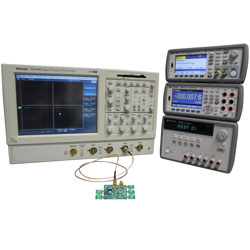
Want to quickly and easily test oscillators more than you can get from IQD using IOSC EVBoard, part of Wurth Elektronik eiSos Group. This evaluation board is ideal for measuring most surface mount standard oscillators, VCXO or TCXO/ VCTCXO.
Six different packing sizes :1.6mm x 1.2mm, 2mm x 1.6mm, 2.5mm x 2mm, 3.2mm x 2.5mm, 5mm x 3.2mm and 7mm x 5mm. The board features six smaller plates that can be snapped off the motherboard and four pad oscillators of varying sizes can be welded onto them. Smaller plates can then be welded to the motherboard
Because noise in the supply voltage can affect the frequency of the oscillator, the board includes a regulator and filter of the supply voltage. Free choice between 1.8V and 5V. This allows the performance of the oscillator to be considered under ideal conditions. However, it may also be necessary to intentionally include noise through testing to see the consequences. For this purpose, the device also offers the option of directly connecting the power supply voltage.
The on/off function can be tested by manually switching to see the effect on the current. In addition, input can be set to "high" or "low" via a digital source to measure the enabling time. For products with voltage-controlled inputs, such as VCXO and VCTCXO, the board incorporates a potentiometer that pulls frequency tolerances and welding results back to the nominal frequency. This process can also be used to manually change the control voltage to simulate the effect on frequency. For sensitive products, such as the VCTCXO, as well as pull-frequency, there is an opportunity to replace potentiometer resistances in applications with fixed resistors. This results in better stability and optimization of jitter as well as phase noise. Of course, the pull input can also be fed via an external analog source.
The board provides three configurations for output signals. Here, the user can choose CMOS output, clip sinusoidal or direct output without buffering or load. All outputs are terminated with SMA connectors.
The unfilled version is currently available free from the company with orders for 200 oscillator samples. The evaluation board offers two options - provide proper BOM as an unfilled PCB and use immediately as a filled board.